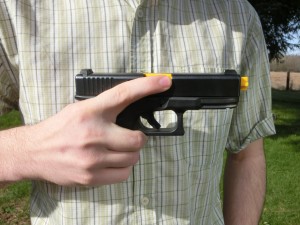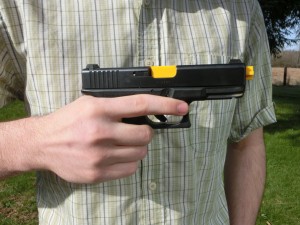By now, even parts of Hollywood seem to have gotten the message about keeping your finger off the trigger until you’re in the very act of firing the gun. That’s good. But that’s not all there is to the story.
From Sandusky, Ohio comes the report of a law enforcement officer who slipped on ice and fell as he prepared to enter a home on search warrant. As he fell, his gun fired unintentionally and the bullet struck him in the leg.
Let me repeat here what I’ve often said before: Like Will Rogers, all I know is what I read in the papers. I don’t have inside information about this event and I wasn’t there. For all I know, everything could have happened 180 degrees different from what the news accounts reported.
However, the story does give us a nice little springboard to talk about where, exactly, we put the finger when we take it off the trigger — and why. I’ve often had experienced shooters in class who let go of the trigger and place it alongside the trigger guard, something like this:
This way of holding the gun, with the trigger finger alongside the trigger guard and slightly relaxed, does get your finger off the trigger. That’s good. It’s much safer than standing there with your finger resting directly on the trigger, and certainly safer than moving around with your finger on the trigger.
But it’s not best, and here’s why: when someone loses their balance or trips, their hands will naturally clench. That same clenched-hand reflex can also be triggered by other causes, such as a simple sneeze or even just hearing a loud noise when you’re tensed up.
With the finger alongside the trigger guard, it’s very likely that any startle response will force that finger right back onto the trigger — with noisy and embarrassing results. That’s why it’s so unsurprising to see a news article about someone who fired a round as he slipped on the ice while he was holding a gun.
Here’s a much better and safer way to get your finger off the trigger:

Place the finger high on the gun’s frame, at the natural limit of movement. This makes it less likely for the finger to slip onto the trigger if the shooter slips and falls.
This change in technique, which places the trigger finger high on the gun’s frame, improves your ability to handle the human startle reflex when you have a gun in your hand. Because the finger is already at its natural limit of movement, it reduces the chances that a sudden slip of the foot will put unexpected holes in things that don’t need to be shot.
With this change in behavior, the shooter can also feel the ejection port underneath his finger. That “felt index” of a specific point on the frame provides the shooter with good feedback about where his finger actually is, which helps reduce the risk of oopsies caused by casual unawareness.
One more thing. Putting the finger high on the frame is a habit, which means it’s something you should do every time you handle the gun — not just when you feel you might slip and fall. Practice this finger placement at the range every time you shoot, and at home every time you pick up the gun. When you build an ongoing, solid habit of holding the gun in the safest and most secure way you can, that makes it much more likely that you’ll do it that way when you’re under stress and moving rapidly.
Stay safe.






One Response to “Finger!”